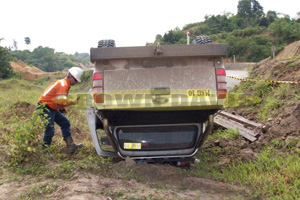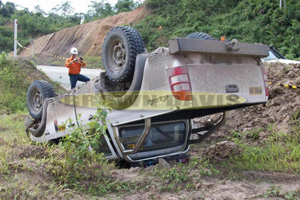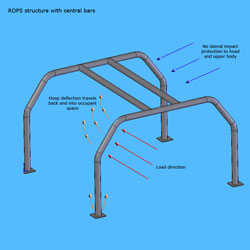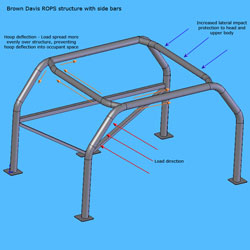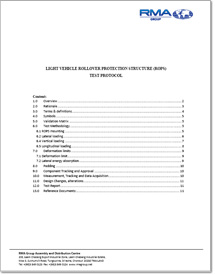


Introduction to Mining Roll Over Protection Structures |
|
A Roll Over Protection Structure (ROPS) is a reinforcement member(s) installed in to, or on to a vehicle with the intention of protecting the vehicles occupants in the event of a roll over accident. The primary intent of a ROPS is to limit the crushing and deformation of the vehicle roof and cabin structure during a roll over accident. This ensures that the vehicle occupants are provided with an adequate amount of survival space which reduces the risk of head, neck/spinal, and upper torso injuries, ultimately preventing death. |
|
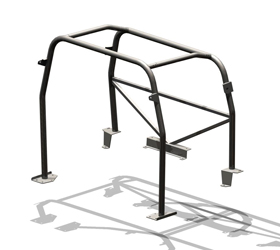 |
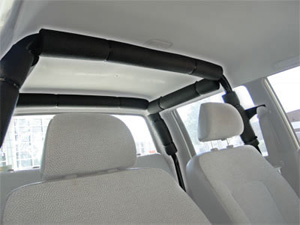 |
Modern production vehicles are designed to meet specific safety standards centred around improving occupant safety. These include seat belts, Supplemental Restraint Systems (Airbags), door latch burst strength, braking performance, and side/frontal impact crumple zone/crash strength. However, these safety features are focused mainly around highway use of sedan type vehicles where roll over is a low occurrence incident. In contrast to that of a sedan, light commercial and four-wheel-drive vehicles have a much higher centre of gravity (CG). Combined with this, new levels of ride comfort, power, and quietness make it far easier to travel at higher speeds than the equivalent type of vehicle in the past. At these speeds, they have a much higher risk of roll over type accidents in situations where evasive or correct steering action is needed. Added to this, the vehicles tendency to carry higher loads reduces the driver's ability to slow the vehicle before encountering such circumstances. |
|
Click images for in cabin image of Brown Davis ROPS preventing cabin deformation |
|
The most common scenario of a rollover accident occurs when quick evasive or corrective steering action is required, and taller and heavier vehicles are more likely to 'trip over'. A vehicles rollover propensity or 'the tendency of a vehicle to roll', can be calculated through a simple mathematical formula of T/2H (where 'H' = height of the Centre of Gravity of the vehicle; and 'T' = vehicle track width). Put simply, the higher the vehicle's centre of gravity, and the narrower the track width, the greater the chance of a rollover accident occurring. A very important and often overlooked aspect to this formula, is that the vehicle's occupants and payload actually raise the vehicle's Centre of Gravity, and can play a big part in the rollover likelihood. Inline with this, having additional mass up high on the vehicle, like that represented by most external ROPS, will result in a higher propensity to rollover. It would seem in conflict to produce a type of ROPS structure that gives the vehicle a higher propensity to rollover. Research conducted by the National Transportation Safety Board in the USA (NTSB/SR-02/03 PB2002-917005) on the rollover propensity of 15-passenger vans directly relating to occupancy level concluded that, 15-passenger vans with 10+ occupants (despite the 15-passenger rating) had 3 times the rollover ratio to that with fewer occupants, thus evidently proving the importance of occupant/load weight on the roll over propensity of a vehicle. |
|
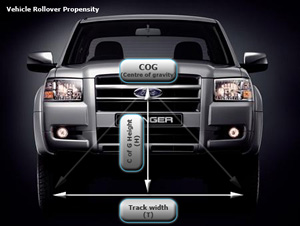 |
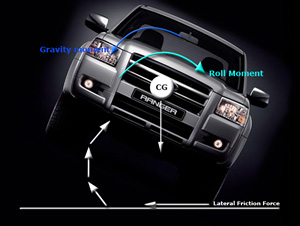 |
The common two types of ROPS are internal or external structures. Internal ROPS (as produced by Brown Davis) are designed to fit inside the cabin space of the vehicle mounting to its floor pan. On the other hand, the external types are designed to fit around the outside of the vehicle cabin mounting to the chassis rails under the vehicle, or behind the cabin as part of the rear tray sometimes extending over the cabin roof. |
|
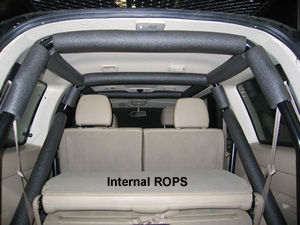 |
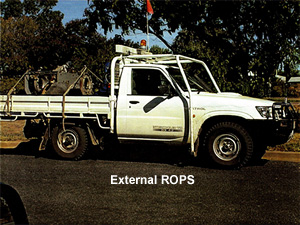 |
Internal
|
External Mounted into the tray of utilities or surrounding the outside of a cabin structure. They significantly dd to the height of the vehicle's centre of gravity.
|
Following on from the Rollover Propensity information, a ROPS weight and its location are very important factors to consider, as they can contribute to the rollover propensity ratio of a vehicle. A Brown Davis internal ROPS kit weighs between 40-50kg for a 4-point dual cab type vehicle and up to 80kg for a 4WD wagon. With them installed inside the cabin, they have little affect on the Centre of Gravity of the vehicle, arguably lowering it. In contrast, some external type ROPS designs currently on the market fitted on the back of utility/pick up type vehicles weigh up to as much as 370kg. Sitting as high up on the vehicle as they do, they would increase the height of the centre of mass and hence, the rollover propensity ratio of the vehicle - thus increasing the chance of rollover compared to internal designs. It would seem illogical to disregard the weight of a roll over protection structure design, that ultimately increases the chance of a roll over taking place. |
|
Although the main function of a ROPS is to prevent cabin deformation in the event of a rollover situation, other aspects of critical impact safety can be improved if they are considered in the design process. Both the structural rigidity, as well as the overall safety benefits of the structure can be optimised. In a perfect world, a rollover would take place on a flat road with no obstacles of objects to impact along the way (In an even more perfect world, roll over accidents would not exist at all!). Unfortunately in reality, this is very rarely the case. Tree's, power poles, fences, rocks, earth embankments and other objects, are often struck in the side and roof region during a roll over accident. The potential for increased severity of the roof deformation with a point load is significant. With this in mind, a ROPS can be designed to further increase occupant safety for these situations. The particular area of design in a 4-point dual cab or wagon style ROPS that can have critical safety benefits, is the placement or structural location of the roof side bars connectin the two structural hoops. Brown Davis has produced and tested countless prototype ROPS designs, whilst constantly adjusting the location of structural components in order to obtain the strongest possible structure. This constant improvement has also lead to offering additional roof deformation protection in point load side impacts. As a result, Brown Davis have proven that having the side bars being located close to the door entries/roof edge, creates a stronger ROPS structure, and retains more than adequate head space for occupants. Locating the side bars in this position greatly enhances the fore/aft strength characteristics of the structure when load is placed on the corner of a hoop in a fore/aft direction. Not only is the structure a lot stronger, having the side bars in this position also prevents penetrating cabin deformation of the side roof rails between the structural ROPS hoops, which would otherwise be unprotected, and leaving an occupant vulnerable to potentially fatal injuries. The CAD image's below show the difference in design and benefits of having side bars placed at the outer regions of the structure. |
|
ROPS with centre positioned bars |
ROPS with side positioned bars |
Click to enlarge images
|
|
Currently there are several standards in place around the world, covering specific forms of ROPS and their requirements for use, unfortunately at this stage there is no standard for Mining use. Below is a break down and their intended use, for each of the current standard regulated ROPS uses: Agricultural and industrial vehicles (primarily tractors - AS 1636 and/or 2294): These types of vehicles tend to operate at low speeds (25km/h approx. maximum) with no likelihood of collision with other vehicles or objects. In addition, these types of vehicles are also generally quite heavy and tall, resulting in the vehicle falling onto its side only - rather than several times over or impact. The ROPS for this category of vehicle are designed to dig into the ground and stop them from sliding. Earthmoving machinery and equipment (AS2294-1997 Parts 1 - 4. & ISO3471, ISO 3449) : Revolves mostly around FOPS or Falling Object Protection Structures, and again generally operate at low speeds and are not likely to be involved in collisions or high speed roll over's. Similar to that required by agricultural and industrial vehicle standards, the typical ROPS/FOPS for this category is designed to stop falling objects penetrating the cabin, and in the event of the machine tipping onto its side; to prevent it from sliding. Motor Racing (FIA - Federation Internationale de l'Automobile - International motorsport governing body): These types of vehicles travel at very high speed, however are of generally light mass. Their ROPS are designed for multiple rollovers with high impact loads. Often side impact and frontal/rear crush re-enforcements are added into their structure. These ROPS, specified and regulated by the FIA (Federation Internationale de l'Automobile), have a long and well documented history of use and offer a foundation for consideration in the design of light commercial vehicle ROPS. ---> Mining vehicles (No current Australian/International standard specific to Mining vehicles): Other than a few internal mining company standards, there are currently no published structural standards requirements specifically for light commercial mining vehicle use. Most states and territories within Australia have registration requirements for occupant space, head room and entry/exit restrictions, but are not performance focused 'standards', and so do not set a benchmark for ROPS roof crush strength.They should not be confused to do so. Registration regulations typically do not contest performance of equipment fitted to vehicles. A good example of this is fitting additional lights to a vehicle; Position of fitment, number of lights fitted, and how they are wired to dip along with the standard lights are all specified for registration, however, the performance of the lights is not controlled. Comparably, the strength of a ROPS is not controlled by such registration requirements as stated above for fitment of a ROPS to a road registered vehicle. |
|
Due to the nature of the above mentioned standards, and the types of vehicles in each category, the most noticeable comparable standard for that of Mining Light Commercial vehicles would be the Motorsport standard. In motorsport regulations, load requirements ask for 7.5 times the vehicle mass in the vertical, 5.5 times the vehicle mass fore/aft, and 3.5 times the mass in horizontal side load. In comparison, the latest testing protocol developed by RM Asia specifically aimed at the mining industry suggests mining ROPS should be capable of protecting against loads of 4 times the GVM in the vertical, 1 times the GVM fore/aft, and 1.5 times the GVM in the horizontal. The Brown Davis testing process and load performance requirements have been developed around the the specific testing criteria for mining vehicles as set out by RM Asia, one of the worlds largest fleet supply organisations. In the absence of a realistic world mining ROPS standard, RM Asia contracted a specialist engineering team to research all worldwide roof crush strength data and documentation to develop a testing protocol document (See test protocol document attached below). This protocol insists on static physical testing only to achieve critical test loads, and gives repeatable real world results which are not attainable in dynamic roll over testing. More of the worlds engineer's and government bodies are now focusing towards static testing over dynamic roll over tests, due to the countless variables inherent in dynamic testing. For repeatable results, and a standard that one can genuinely compare one rops structure to another, physical testing is the only measure. The likely maximum energy that a ROPS structure could be required to be absorbed in any accident is directly proportional to its Mass, and a square function of its Velocity. The following equation for kinetic energy states that : E = 1/2 x M x V2 (where E = kinetic energy, M = vehicle mass in Kilograms, V = velocity of vehicle in meters per second squared). With this equation we can show the differences in energy between a motorsport vehicle and that of an average mining vehicle. Doing some simple calculations on the average motorsport and mining vehicle, the results make it easy to see where, as an example; Shell Oil obtain their load level requirements of 3 times the GVM in the vertical, 3 times the GVM fore/aft, and 1.5 times the GVM in the horizontal. The ratio difference in loading is approximately 2:1; practically the same as the difference in load requirements between current motorsport regulations and Shell Oil's internal load requirements. For example - the difference between the average motorsport vehicle energy, and that of a standard mining ROPS vehicle:
Ratio = 2082916.67 : 1041083.42 Simplified (approx) = 2 : 1 The aforementioned suggests that the current motorsport standard is in fact a valuable resource and foundation that can be called upon and adapted to be used as a mining standard until a specific mining ROPS standard is brought into place. RM Asia have done exactly this with their new ROPS testing protocol, and ended up with requirements that are very understandable, given the likely energy levels of the two categories of vehicles and their individual roll over accident characteristics. Thus, Brown Davis has adopted RM Asia's suggested load levels as an in house standard. Brown Davis also uses a maximum deflection of 100mm as the 'fail' point. Due to the size of a cabin in light commercial mining vehicles, more than 100mm of deflection, will result in the occupant's survival space becoming compromised, and the effectiveness of the ROPS is negated. All Brown Davis ROPS MUST withstand the RMA test protocol loads, with less than 100mm of tube deflection to be considered as a suitable ROPS design for the mine industry. |
|
Most current day safety equipment, in any occupation, comes with some form of compromise. A mining ROPS is no different. For example; Wearing a bullet proof vest and protective clothing for a soldier in the scorching heat of an Afghani desert would never be questioned, as the discomfort is considered to be minor compared to its life saving and vital benefits of bodily protection. Comparably, common safety hard hats, steel cap work boots and protective gloves are considered the norm in almost all industries. Again, their restriction in work ability is considered far less of an inconvenience than the huge increase in personal safety that they represent. Inline with this, and despite extraordinary measures taken in ROPS design by Brown Davis, the slight ergonomic restriction of an internal ROPS in some vehicles cabins, for mine application, is far outweighed by the improvement in occupant safety as compared with the questionable roll over strength of other designs. |
|

©Brown Davis 2009 - www.browndavis.com.au
